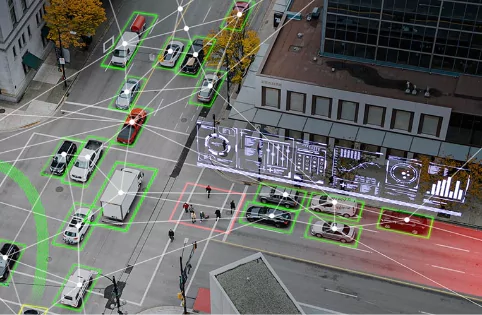What Are Intelligent Systems?

Intelligent systems are increasingly at play in urban lighting, transportation, traffic control, and much more.
Essential components of intelligent systems include:
- Data: Intelligent systems heavily rely on data. They collect vast amounts of information from various sources, such as sensors, cameras, and the internet. This data serves as the foundation for decision-making and learning.
- Algorithms: Algorithms are the brainpower behind intelligent systems. They process and analyze data, extracting patterns and insights. ML algorithms are responsible for making predictions and decisions based on this analysis.
- Learning: Intelligent systems can learn. They use ML techniques to adapt and improve their performance with experience and exposure to new data.
- Automation: Automated systems reduce the need for human intervention in repetitive or complex processes.
Types of Intelligent Systems
Intelligent systems encompass a wide range of applications, each designed to solve specific problems and tasks. Common types of intelligent systems include:
- Autonomous vehicles: Self-driving cars and drones use intelligent systems to navigate and make real-time decisions that ensure safety and efficiency.
- Healthcare and medicine: Intelligent systems are employed for disease diagnosis, drug discovery, and treatment recommendations.
- Natural language processing (NLP): NLP systems such as chatbots and virtual assistants can understand and respond to human language. They are used in customer service, content generation, and language translation.
- Computer vision: Systems that can analyze and interpret visual information from images and videos are applied in facial recognition, object detection, and medical image analysis.
- Recommendation systems: Systems that analyze user behavior and preferences can provide personalized recommendations, often seen in online shopping platforms and streaming services.
Intelligent systems impact many aspects of society, offering improved efficiency and advancements in and personalization of AI-driven systems. They also give rise to ethical concerns around data privacy, bias, and accountability.
Embedded Intelligent Systems
In the context of embedded software, intelligent systems represent a fusion of traditional software engineering and AI techniques. This has given rise to a new generation of smart and adaptive embedded systems, with enhanced capabilities that make them more autonomous, efficient, and responsive to changing conditions. These capabilities include:
- Data sensing and processing: Embedded intelligent systems are equipped with sensors and data processing capabilities so they can collect and analyze information from their surroundings. This data can include environmental parameters, user inputs, or sensor readings. This real-time data processing is crucial for informed decision-making and prompt responses to change.
- Adaptive behavior: Related to their ability to use data is one of the defining characteristics of intelligent embedded systems: They can adapt to varying environments and situations. Unlike conventional embedded software that follows preprogrammed rules, intelligent embedded systems can learn from data and adjust their behavior accordingly. For instance, an intelligent thermostat embedded in a smart home can learn the occupants’ preferences for temperature and adjust settings automatically.
- Decision-making and control: Intelligent embedded systems often incorporate decision-making algorithms based on AI and machine learning. This enables them to make complex decisions autonomously — a self-driving car can navigate through traffic; a smart thermostat can optimize energy usage while maintaining user comfort.
- Energy efficiency: Intelligent embedded systems are designed with energy-efficient algorithms to maximize battery life and reduce energy consumption while still providing intelligent functionality. This is particularly important in applications such as wearable devices and IoT sensors.
- Safety and reliability: Embedded intelligent systems must adhere to rigorous safety standards and be thoroughly tested to ensure they perform reliably even under extreme conditions.
- Connectivity: Many intelligent embedded systems are part of larger IoT ecosystems, requiring seamless connectivity to communicate with other devices and cloud services. Connectivity enables remote monitoring, software updates, and data sharing between systems.
- Security: The integration of AI and connectivity introduces security challenges. Protection against cyberthreats, unauthorized access, and data breaches is of utmost concern, especially in certain areas such as smart grids and industrial automation.
- Real-time responsiveness: Some systems, such as robotics and medical devices, require real-time responsiveness. Intelligent embedded software must meet stringent timing requirements to ensure safety and performance. Real-time operating systems and specialized hardware may be used to achieve this.
- Upgradability: Intelligent embedded systems benefit from the ability to receive software updates and improvements over time so they can evolve, meet changing requirements, and remain relevant long after deployment.
Embedded intelligent systems are useful in just about every market, including aerospace and defense, automotive, manufacturing, medical, telecommunications, transportation, and more.
Key Characteristics of Intelligent Systems

Recent research indicates that a well-defined set of characteristics combine to create the most successful intelligent systems.
Eight in 10 leaders say they want to achieve success with intelligent systems in the next decade, according to Wind River® research. To create successful intelligent systems, it is important to understand what to invest in, when to invest in it, and what the desired economic and innovation-based outcomes are.
The best blueprint for developing intelligent systems varies across industries. But there are 13 general characteristics that drive success in intelligent systems:
- True compute on the far edge: Devices can fully function in near-latency-free time on the farthest edge of the cloud.
- Customized device experience in the cloud: The system can program, adjust, deploy, and operate a device (or set of devices) through a single pane of glass.
- Action based on sensory data and algorithms: The device can sense data inputs and then change how it acts depending on readings from that data.
- Digital feedback loops that influence product development: Data feeds into systems during the development, deployment, and/or operational phases, providing insights and instructions to adjust performance and build in updates.
- Automated learning and ML functionality: The system can infuse automated learning and machine learning (ML) throughout the device or system lifecycle.
- Simulating and emulating in near real time: The system can test a near-infinite number of real-world scenarios at any stage of the device lifecycle.
- Experimenting as a learning system: The system can adjust based on deterministic approaches or live learning and can adapt based on developing rules.
- Real-time collaborative workflow platform: Knowledge workers and AI copilots can jointly create elements of the system’s development, deployment, and service needs within a single pane of glass.
- Near-real-time, seamless multiple ecosystem connections: Ecosystems support connection of applications into the development or operations of embedded devices, in any phase of the device lifecycle. This includes applications for code development, security, AI/ML algorithms, or even permissions.
- Total automation: Processes can be fully automated with no human input. For example, testing code or functionality can be automated, as can the deployment and operations processes.
- Detection and resolution of events: The embedded device or system can recognize that a potential event or issue (good or bad) is likely to occur and then instruct other systems to resolve that event or issue.
- Ability to predict stresses and failures: The system can use models to test and predict failure moments in systems.
- Adapting tasks based on reprogramming via the cloud: Tasks of a device or complete system can be increased, decreased, or changed without anyone having to physically retrieve that device or system.
» Learn More About the Characteristics of Intelligent Systems by Industry
How Can Wind River Help?

Wind River solutions support intelligent embedded systems whose performance demands low latency, security, and safety.
Wind River Edge
VxWorks
VxWorks® is a real-time operating system (RTOS) that is widely used in intelligent systems across industries, including aerospace and defense, automotive, industrial, medical, and more. It provides a robust and reliable foundation for developing and running embedded and real-time applications. VxWorks is often used in autonomous vehicles, robotics, and critical infrastructure systems for which real-time performance and safety are paramount.
Wind River Helix Virtualization Platform
Wind River® Helix™ Virtualization Platform enables the consolidation of multiple operating systems and applications on a single hardware platform. It’s commonly used in intelligent systems that run multiple operating systems or applications in isolated environments where both real-time and general-purpose operating systems may coexist.
» Learn More About Helix Platform
Wind River Linux
Wind River offers a commercial-grade Linux distribution tailored for embedded and intelligent systems. Wind River Linux includes tools and features for building secure, high-performance, and customizable Linux-based platforms. It’s often used in networking equipment, medical devices, aerospace and defense systems, IoT devices, and other embedded intelligent systems.
» Learn More About Wind River Linux
Wind River Studio
Wind River Studio is a cloud-native platform for the development, deployment, and operation of intelligent systems and IoT devices. It provides tools and services for managing the entire lifecycle of intelligent systems, including development, deployment, and monitoring.
Studio has been architected to easily scale to simultaneously run different projects with multiple operating systems and hardware architectures, all from a single pane of glass. It allows development teams to develop in the cloud, collaborate through CI/CD workflows, integrate applications, automate processes, and easily manage updates.